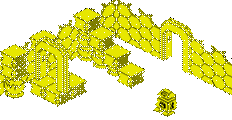Atari 5200 [SuperSystem]
Vital Statistics
Introduced
November 1982 |
|
![]()
What's it like today?
|
In 1982 the Atari 2600 was getting rather old and Atari needed a new video game console that would compete directly with it's competitors. Their answer was the Atari 5200 SuperSystem.
This new cartridge-based console featured improved graphics and several features not found on any systems available at the time. At it heart it was actually An Atari 400/800 computer, which at the time was the most powerful 8-bit home computer. This in theory would allow Atari to easily port games from the 400 and 800 across to the 5200 or back. This turned out to be one of its downfalls, since it was not backwardly compatible with its best-selling and still popular predecessor, the 2600. A 2600 compatibility cartridge
The controllers were totally new too, and could be stored in the back of the console. A cross between a trackball and a conventional joystick, and featuring a numeric keypad on the base, these were very advanced for the time. They were also analog, which meant full 360 degree mobility. Unfortunately, they turned out to be unreliable in use, and partly due to their lack of self-centering, caused much frustration with players of certain games.
At its launch, the software on sale consisted mostly of tired classics that failed to utilise the 5200's audio/visual talents. Titles such as Super Breakout, Galaxian and Space Invaders were unsuccessful in generating excitement among gamers who were looking for the "next wave" in console gaming.
Earlier 5200 units sold with 4 controller ports also featured a special RF switch box which the power supply connected into. This allowed the user to be able to switch between "TV" and "Game" without having to remove RF leads from the back of the television. Later 2-port systems reverted to the standard RF box, without a switch.
At time of release, Atari renamed their products after their model numbers, so the VCS became the CX-2600 (shortened to just 2600). This was in order to make its product range more consistent.
By 1983, the home computer market was in major decline, and despite the 5200 still outselling the Colecovision after it has "bedded-in" with a number of quality game releases, Atari decided to cease manufacture and distribution the following year.
The 5200 SuperSystem was never released in Europe.










